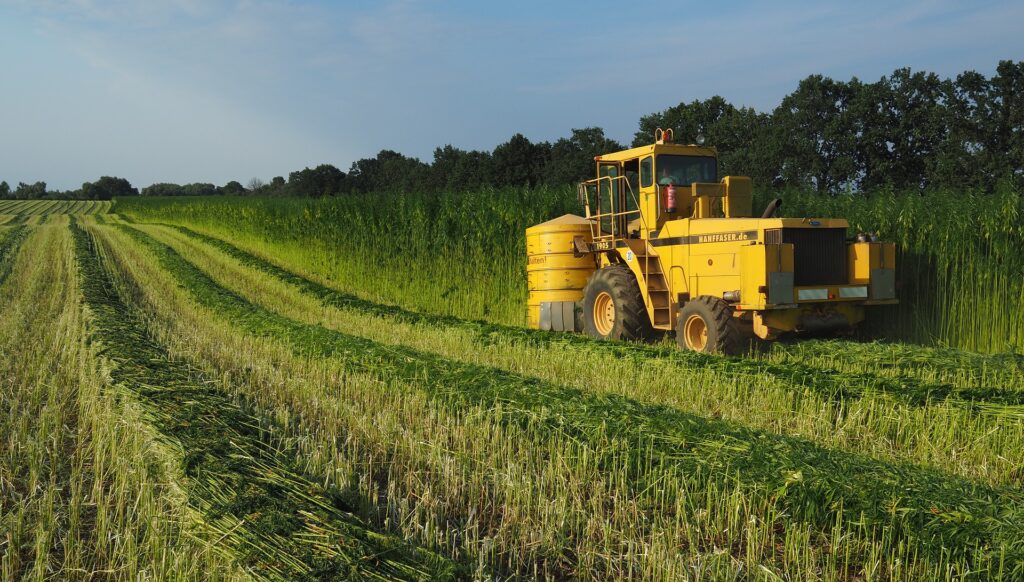Водопотребление промышленной конопли (Cannabis sativa L.) на участке в северном Казахстане
Нильс Тевс a,b* , Кумар Алиев a
a Центральноазиатский офис, CIFOR-ICRAF, ул. Токтогула 141, 720001 Бишкек, Кыргызстан
b Gesellschaft für Internationale Zusammenarbeit (GIZ), Friedrich-Ebert-Allee 32+36, 53113 Бонн, Германия
* E-mail: N.Thevs@cgiar.org
https://doi.org/10.29258/CAJWR/2022-R1.v8-2/1-18.eng
Аннотация
Цель: В данном исследовании изучалось водопотребление (эвапотранспирация культуры) промышленной конопли на недавно созданном конопляном поле в Акмолинской области Северного Казахстана. Методология: Водопотребление конопли исследовалось путем прямых измерений сокодвижения во второй половине вегетационного периода 2021 года. Эти данные позволили получить данные по водопотреблению. Водопотребление первой половины вегетационного периода оценивалось с помощью метода Пенмана-Монтейта по методике FAO. Выводы: Потребление воды коноплей составило 353 мм за вегетационный период при урожайности 10 т/га. В условиях водоснабжения на исследуемом участке конопля обеспечивает более высокую урожайность, чем сенокосные угодья или зерновые культуры. Оригинальность/ценность исследования: Впервые выявлены данные по водопотреблению конопли для региона Центральной Азии как потенциального сырьевого растения для биоэкономики.
Доступно на английском
Download the article (eng)Для цитирования: Thevs, N., Aliev, K. (2022).Water consumption of industrial hemp (Cannabis sativa L.) from a site in northern Kazakhstan. Central Asian Journal of Water Research, 8(2), 19–30. https://doi.org/10.29258/CAJWR/2022-R1.v8-2/19-30.eng
Список литературы
Allen, R.G., Pereira, L.S., Raes, D. & Smith, M. (1998). Crop evapotranspiration – Guidelines for computing crop water requirements. FAO Irrigation and drainage paper 56. Rome: FAO.
Amaducci, S. & Gusovius, H. J. (2010). Hemp-cultivation, extraction and processing. In J. Müssig (Ed.). Industrial Applications of Natural Fibres: Structure, Properties and Technical Applications (pp. 109–134). West Sussex: John Wiley Sons Ltd.
Babaei, M. & Ajdanian, L. (2020). Screening of different Iranian ecotypes of cannabis under water deficit stress. Scientia Horticulturae, 260, 108904. https://doi.org/10.1016/j.scienta.2019.108904.
Baier, C., Thevs, N., Villwock, D., Emileva, B. & Fischer, S. (2021). Water Productivity of Paulownia Tomentosa × Fortunei (Shan Tong) in a Plantation at Lake Issyk-Kul, Kyrgyzstan, Central Asia. Trees. https://doi.org/10.1007/s00468-021-02141-8.
CACILM and ADB (Central Asian Countries Initiative for Land Management and Asian Development Bank) (2010). Central Asia Atlas of Natural Resources. Manila, Philippines: CACILM and ADB. http://www.adb.org/sites/default/files/publication/27508/central-asia-atlas.pdf.
Clearwater, M.J., Meinzer, F.C., Andrade, J.L., Goldstein, G. & Holbrook, N.M. (1999). Potential errors in measurement of nonuniform sap flow using heat dissipation probes. Tree physiology, 19, 681–687. https://doi.org/10.1093/treephys/19.10.681.
Climate data. (2021) https://de.climate-data.org [In German]
Consentino, S.L., Riggi, E., Testa, G., Scordia, D. & Copani, V. (2013). Evaluation of European developed fibre hemp genotypes (Cannabis sativa L.) in semi-arid Mediterranean environment. Industrial Crops and Products, 50, 312-324. http://dx.doi.org/10.1016/j.indcrop.2013.07.059.
Eisfelder, C., Klein, I., Niklaus, M. & Kuenzer, C. (2014). Net primary productivity in Kazakhstan, its spatio-temporal patterns and relation to meteorological variables. Journal of Arid Environments, 103, 17-30. https://doi.org/10.1016/j.jaridenv.2013.12.005.
Flo, V., Martinez-Vilalta, J., Steppe, K., Schuldt, B. & Poyatos, R. (2019). A synthesis of bias and uncertainty in sap flow methods. Agricultural and Forest Meteorology, 271, 362-374. https://doi.org/10.1016/j.agrformet.2019.03.012.
García-Tejero, I.F., Durán-Zuazo, V.H., Pérez-Álvarez, R., Hernández, A., Casano, S., Morón, M. & Muriel-Fernández, J.L. (2014). Impact of Plant Density and Irrigation on Yield of Hemp (Cannabis sativa L.) in a Mediterranean Semi-arid Environment. Journal of Agriculture, Science, and Technology, 16, 887-895.
Granier, A. (1985). Une nouvelle méthode pour la mesure du flux de sève brute dans le tronc des arbres. Annales des Sciences forestières EDP Sciences, 42-2, 193-200.
Ingrao, C., Bacenetti, J., Bezama, A., Blok, V., Goglio, P., Koukios, E.G., Lindner, M.,
Nemecek, T., Siracusa, V., Zabaniotou, A. & Huisingh, D. (2018). The potential roles of bio-economy in the transition to equitable, sustainable, post fossil-carbon societies: Findings from this virtual special issue. Journal of Cleaner Production, 204, 471–488. https://doi.org/10.1016/j.jclepro.2018.09.068.
Kusainova, A.A., Mezentseva, O.V. & Tusupbekov, Z.A. (2020). Influence of precipitation variability and temperature conditions on the yield of grain crops in Northern Kazakhstan. IOP Conf. Series: Earth and Environmental Science, 548, 042026. doi:10.1088/1755-1315/548/4/042026.
Lisson, S. & Mendham, N. (1998). Response of fiber hemp (Cannabis sativa L.) to varying irrigation regimes. Journal of the International Hemp Association, 5(1), 9-15.
Moscariello, C., Matassa, S., Esposito, G. & Papirio, S. (2021). From residue to resource: The multifaceted environmental and bioeconomy potential of industrial hemp (Cannabis sativa L.). Resources, Conservation, and Recycling, 175, 105064. https://doi.org/10.1016/j.resconrec.2021.105864.
Noghabi, S.G., Shahidi, A. & Homami, H. (2021). Estimation of Water Requirement and Crop Coefficient for Hemp at Different Growth Stages in Birjand Plain. Journal of Water Research in Agriculture. DOI: 10.22092/jwra.2021.122794.
Oishi, A.C., Hawthorne, D.A. & Oren, R. (2016). Baseliner: An open-source, interactive tool for processing sap flux data from thermal dissipation probes. SoftwareX, 5, 139–143. https://doi. org/10.1016/j.softx.2016.07.003.
Reliable prognosis. (2021) www.rp5.ru
Reyer, C.P.O., Otto, I.M., Adams, S., Albrecht, T., Baarsch, F., Cartsburg, M., Eden, A., Ludi, E., Marcus, R., Mengel, M., Mosello, B., Robinson, A., Schleussner, C.-F., Serdeczny, O. & Stagl, J. (2017). Climate change impacts in Central Asia and their implications for development. Regional Environmental Change. doi 10.1007/s10113-015-0893-z.
Smith, D.M. & Allen, S.J. (1996). Measurement of sap flow in plant stems. Journal of Experimental Botany, 47, 1833–1844. https://doi.org/10.1093/jxb/47.12.1833
Strenge, E., Thevs, N., Aliev, K., Eraaliev, M., Lang, P. & Baibagysov, A. (2018). Water consumption of Populus alba trees in tree shelterbelt systems in Central Asia. Central Asian Journal for Water Resources, 4, 48-62. https://www.water-ca.org/api/v1/articles/5955-water-consumption-of[1]populus-alba-trees-in-tree-shelterbelt-systems-in-central-asia.pdf.
Struik, P. C., Amaducci, S., Bullard, M. J., Stutterheim, N. C., Venturi, G., & Cromack, H. T. H. (2000). Agronomy of fibre hemp (Cannabis sativa L.) in Europe. Ind. Crops Prod, 11, 107–118. doi: 10.1016/S0926-6690(99)00048-5.
Thevs, N., Gombert, A.J., Strenge, E., Lleshi, R., Aliev, K. & Emileva, B. (2019). Tree wind breaks in Central Asia and their effects on agricultural water consumption. Land, 8, 167 – 183. https://doi. org/10.3390/land8110167
биомасса, биоэкономика, текстильная фабрика, Центральная Азия, эвапотранспирация